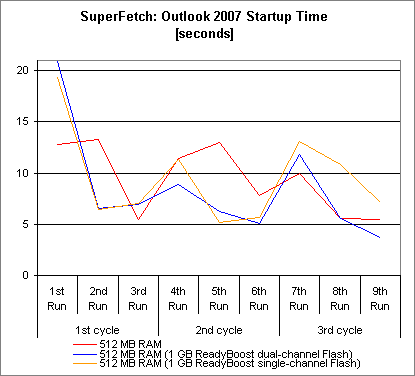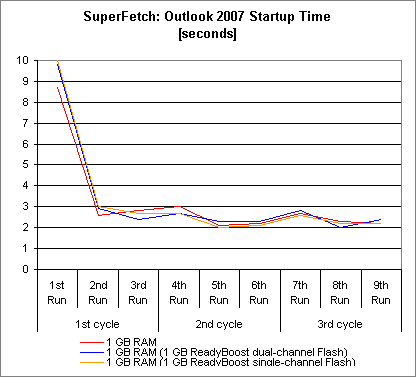Analysis: Vista's Ready Boost is no match for RAM
ReadyBoost application performance
Test setup
We took a look at the ReadyBoost feature by utilizing two different USB 2.0 Flash memory sticks (a fast one and an average one), launching a selection of popular Windows applications. To make the whole analysis useful for as many users as possible, we did not use a high-end computer, but we put together a setup that is roughly two years old: A Pentium 4 processor 620 (2.8 GHz), 512 MB and 1 GB of RAM and a 7200 RPM Seagate Barracuda hard drive.
We tested this setup with Microsoft Outlook 2007 and a 1.4 GB PST file, which is the file containing your contacts, calendar and email data. The second application was Apple's iTunes 7, which we loaded with several hundred megabytes of music. Last but not least we had the Adobe Acrobat Reader 8 open a 22 MB PDF document, containing 1273 text pages.
We did a total of nine runs launching all three applications, using 512 MB and 1 GB RAM, without an USB 2.0 Flash device, with the dual-channel device by Kingston or the single-channel device by Memina. We assigned 1 GB memory in both cases.
Every three runs we restarted the test system to see how well SuperFetch actually works. We also waited 90 seconds before launching each application, because we wanted SuperFetch to have enough time to do its homework and buffer application data into available RAM or the USB 2.0 ReadyBoost drive. Details on the USB 2.0 Flash memory sticks used can be found here.
Microsoft Outlook 2007 startup time
With only 512 MB RAM, starting Outlook 2007 for the first time took painfully long. But SuperFetch learns: On average, startup time decreased from 12 to 8 seconds over time. Using USB 2.0 devices has an interesting impact: While initially the startup time increases to as much as 20 seconds, it decreases considerably as SuperFetch learns that Outlook is launched repeatedly. The orange curve represents the slow, single-channel USB 2.0 Flash device. Note that it does not necessarily improve application startup performance.
At 1 GB RAM, the situation is entirely different: Only the first Outlook 2007 call, which is done off the hard drive, takes 9-10 seconds. From the second start and on, launch time for Outlook shrinks to as little as 2-3 seconds. Whether attaching a USB 2.0 Flash drive to assist SuperFetch makes sense or not remains questionable here.
Get Tom's Hardware's best news and in-depth reviews, straight to your inbox.
Current page: ReadyBoost application performance
Prev Page Next Page ReadyBoost application performance, Continued
Patrick Schmid was the editor-in-chief for Tom's Hardware from 2005 to 2006. He wrote numerous articles on a wide range of hardware topics, including storage, CPUs, and system builds.


